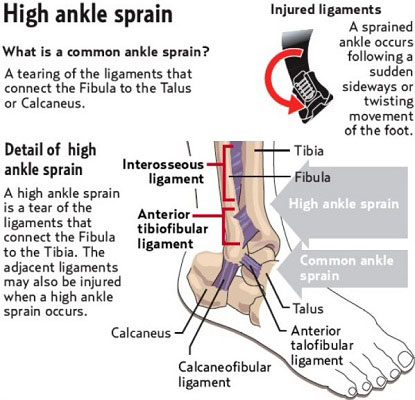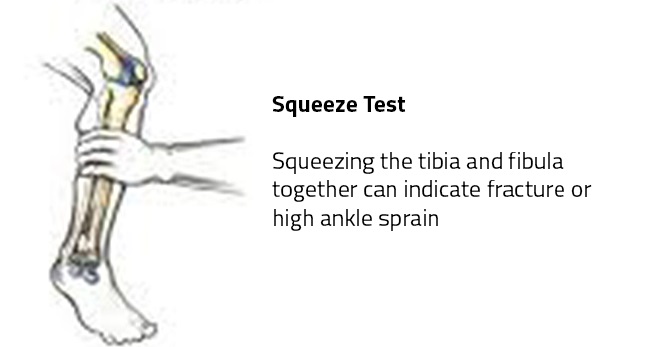A high ankle sprain is an injury to the upper ankle joint ligaments placed on top of the ankle joint. These ligaments are connected to the fibula and tibia, stabilizing the entire area for running and walking activities. These high ankle ligaments connect your tibia to the fibula. The injury involves the syndesmosis between the lower shinbone and fibula just on top of the ankle joint. The syndesmosis is a fibrous joint wherever the two-leg bones are connected by ligaments and usually have very little mobility. High ankle sprains also are known as syndesmotic ankle sprains, whereas the bone and ligaments are involved.
High ankle sprains will happen after you have broken ankle bones. Sometimes, these will happen once the deltoid ligaments, the ligaments on the inside of your ankle joint, are torn. You might feel pain within the deltoid area, in the ligaments of the high ankle, or within the fibula. High ankle sprains are much less common, however, are more disabling than your traditional lower ankle sprain.

High Ankle Sprain Causes
A high ankle sprain is caused by an inversion or dorsiflexion trauma to the syndesmosis, resulting from a swift twisting, turning or cutting motion while an individual is running or jumping. High ankle sprains are most prevalent in athletes who participate in high-impact running sports like football, soccer, basketball, and lacrosse.
The finest way to omit this injury is through continual performance training for strength and flexibility, incorporating appropriate stretching exercises
High Ankle Sprain Symptoms & Signs
Having typical symptoms of an ankle sprain like pain and swelling. If you’ve intimate with a high ankle sprain, you would possibly put weight on your foot and ankle; however, you’ll have pain on top of your ankle, between your fibula and shinbone. The pain felt above the ankle joint that exaggerated with outward rotation of the foot.
You’ll probably experience more pain once climbing up or downstairs or participate in any activities that cause your ankle bones to flex upward. Pain over the posterior side of the ankle is of particular concern and will be associated with an avulsion fracture or bone bruising.
A high ankle sprain also can lead to a fractured fibula. If you’ve fractured one bone in your ankle in conjunction with a high ankle sprain, you won’t be able to put weight on that foot. You, furthermore, may not be able to perform a single leg calf raise.
High Ankle Sprains Diagnosis
If you’re thinking that you’ve experienced a high ankle sprain, see your doctor. They’ll diagnose the sort of sprain you’ve undergone.
Your physician can ask you to explain to them where you’re having the pain in your ankle. Then, your physician can check you to figure out where it refers to your pain to another area of your foot, ankle, or leg.
They might squeeze your leg underneath your knee or rotate your leg and ankle toward the outside. The location of your pain can help your physician make out where the sprain is. Pain in the upper ankle ligaments implies that you’ve got a high ankle sprain.
High Ankle Sprain Test
Dorsiflexion External Rotation Stress Test known as Kleiger’s Test
- Determines rotator destruction to the deltoid ligament or the distal tibiofibular syndesmosis.
- Performed by considering the knee flexed by 90 degrees with the ankle in a neutral position and employing an external rotational pressure to the affected foot and ankle.
- (+) test: Pain in the anterolateral ankle. A symbol of deltoid ligament destruction would be if there is a displacement of the talus away from the medial malleolus.

Squeeze Test
- Separation of the tibia and fibula.
- Identifies a fibular fracture or syndesmosis sprain.
- Performed by squeezing the tibia and fibula together above the injury.
- (+) test: it will reproduce pain along the fibular shaft if it’s a fibular fracture and the distal tibiofibular joint for a syndesmosis sprain.
Your physician can further want to require some X-rays of your ankle and leg to rule out broken bones or other injuries. If they think a high ankle sprain or syndesmosis injury, they will suggest a weight-bearing X-ray to make sure the diagnosis.
If your surgeon suspects you will have a further injury to the ligaments in your upper ankle area, they will conduct an MRI or CT scan.
Recommended Post
- Top Rated ASO Ankle Brace for Ankle Support
- Best Ankle Brace for Achilles Tendonitis Support
- Top-Rated Aircast Airsport Ankle Brace Reviews
- Best Shoes For Plantar Fasciitis As Per User Reviews
- Most Comfortable Steel Toe Boots For Standing All Day
High Ankle Sprain Treatment Protocol
High ankle sprains take longer to heal than the more common strains. The standard high ankle sprain treatment is the same as the RICE Protocol used for a common ankle sprain. Here are the steps you’ll take throughout the healing process.
First, your doctor might advise you to ice your ankle every few hours for about 20 minutes at a time.
Wrapping your leg with a lightweight patch and elevating it, besides icing, also can help relieve pain and swelling.
Taking anti-inflammatory over-the-counter medicines like non-steroidal anti-inflammatory drugs or ibuprofen will help cut back inflammation and pain at the injury site.
You must keep weight off your injured ankle and tape or high ankle sprain brace in the injured area. Sometimes, high ankle sprains will need to use crutches or wear a boot that permits you to walk on your foot whereas conjointly properly positioning the ankle and foot for healing.
It additionally needs physical therapy most times. Therapy will demonstrate high ankle sprain exercises that facilitate strengthening your tendons to assist prevent a recurrence of this ankle sprain.
It is necessary to have stability between the shinbone and fibula at this level because there’s a tremendous amount of force that passes through this area once walking and running. Some rotation of the fibula to the shin is permitted by these ligaments.
Once you rupture or overstretch these high ankle ligaments, the bones of your lower leg move apart with each step inflicting pain and loss of your passive ankle stability. You’ll usually need crutches or a walking boot throughout this phase. Whereas high ankle sprain surgery is the need for unstable injuries, stable injuries may treat conservatively. High-quality physical therapy is suggested in both conservative and post-operative rehabilitation processes.
High Ankle Sprain Recovery Time
High ankle sprains are more severe than the common mortise joint sprain and can usually take longer to heal. Ankle sprains should be diagnosed early stage and appropriate treatment started, which differs from a lower ankle sprain. If the injury is stable, then the high ankle sprain may be treated in a cast or walking boot, typically for 6 weeks.
Grade 1 – Mild High Ankle Sprain Recovery Time
In mild cases, you’ll expect full ligament healing at close to 6 weeks; however, it should take longer to prepare you for functional sport again.
Despite most people being advised to “rest” and it’ll recover, we discover that these mild sprains usually lead to joint stiffness, ligament laxness, muscle weakness or tightness and reduced proprioception (joint awareness and balance).
If not appropriately treated these frequently cause your ankle and foot joints, which might cause several other injuries months or years down the track.
Grade 2 – Moderate High Ankle Sprain Recovery Time
Grade 2 injuries occur once you have a significant ligament injury that permits the ligament to overly stretch. In most cases, these injuries lead to a recovery period of six to twelve weeks. With increasing injury severity, the rehabilitation method becomes more complicated and intensive. Grade 2 injuries are often stable or unstable. Unstable injuries would require surgery.
Grade 3 – Severe High Ankle Sprain Recovery Time
Grade 3 ligament injuries are once the ligament is totally damaged. More severe high ankle sprain injuries may embody fractures of the bones or high ankle sprains, which can need further rehabilitation time to a simple ankle sprain. If there’s too much separation between your shinbone and fibula, for instance, your doctor could suggest corrective surgery. Here, you need to wear a cast or a boot for around 3 months, whereas you recover, then come to physical therapy.
Patients can have the screw in situ for 3 months, whereas the syndesmotic ligament heals. Patients should understand that if they walk on the leg whereas the syndesmotic screw is in their leg (even once the ligament has healed) will break. The reason for this is that there’s usually some motion between these bones once people walk.
The high ankle sprain rehab of a Grade 3 ankle sprain commonly takes 3 to 6 months however a variable reckoning on your specific injury. Your physiotherapist or surgeon can offer you more specific tips and recommendations.
Usually, the long-run outcome is nice for a high ankle sprain. Your ankle may well be stiff and troublesome to move for a prolonged period than the typical, more common sprains. With the correct treatment, your high ankle sprain will heal fully. If you’re an athlete or not, you must use a brace or tape your ankle to avoid the repetition of the injury. Arthritis may occur in the future if not treated.
